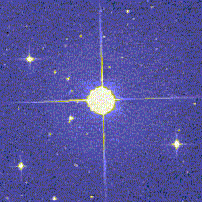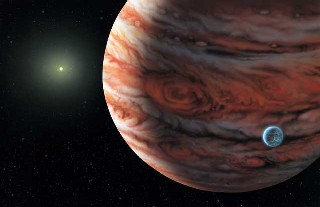
Courtesy of NASA/JPL
More than 100 planets orbit distant stars!
News story originally written on September 25, 2002
Astronomers have identified another exoplanet, that is, a planet outside our solar system. This makes a total of 102 exoplanets that have so far been found by astronomers!
The astronomers that identified this exoplanet, have been searching outside our solar system for planets that are similar to Earth. The planet they found is circling the star Tau1 Gruis and is three times as far from its star as Earth is from the Sun. The newly discovered planet has a mass similar to that of Jupiter. The solar system of this newly discovered planet is organized a bit like ours, with the planets strung out in a line from the star and the larger ones further away.
How do astronomers find exoplanets? They look for stars that appear to wobble because of the gravitational pull of orbiting planets. The wobble can be detected by a Doppler shift in the starís light indicating the presence of a planet. This is then fine tuned to assess the planetís distance from the star and mass.
After astronomers have a good idea which of the exoplanets are like Earth, their next step is to look for evidence of life by analyzing the chemistry of the planet and its atmosphere, searching for carbon, carbon dioxide, and ozone. Perhaps they will someday find evidence that we are not alone in the universe!














